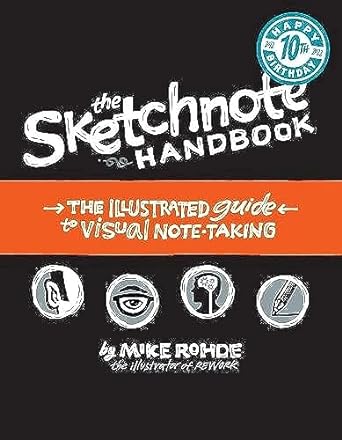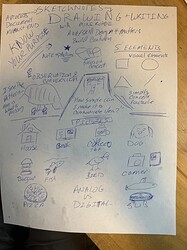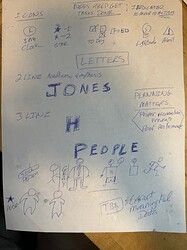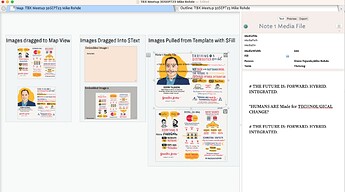Tinderbox Meetup Saturday 30 Sept. Video: With Mike Rohde, Author of The Sketchnote Handbook and The Sketchnote Workbook
| Level | Intermediate |
| Published Date | 9/30/23 |
| Type | Meetup |
| Tags | 5Cs, 5Cs Learning and Knowledge Management, AI, Badges, CKM, Caputre Ideas, Design Thinking, Endless Experimentation, Graphic Listening, Ideas Not Art, Knowledge Management, Memory, Mindset, PKM, Personal Knowledge Management, Purpose, Tinderbox, Visual Thinking |
| Video Length | 01:45:33 |
| Video URL | https://youtu.be/Sm4X0RRniqg |
| Example File | TBX Meetup 30SEPT23 Mike Rohde.tbx (5.0 MB) |
| Chat | chat.txt (3.9 KB) |
| TBX Version | 9.6 |
| Host | Michael Becker |
In this Tinderbox Meetup, Mike Rohde, author of the Sketchnote Handbook and The Sketchnote Workbook, joined us to explain visual note-taking (his history as print, web, and user experience designer[how people actually use tools]).
Book: Sketchnote Handbook The illustrated guide to visual note taking
get 40% off with 40% code
ROHDE40

Sketchnotes with Mike Rohde
Mike’s Background
Mike shared
- his origin story with us
- the evolution of his visual note-taking process, and
- the steps of Sketchnote taking
About Mike
Mike Rohde is a designer, teacher, and author of The Sketchnote Handbook and The Sketchnote Workbook, co-creator of The Sketchnote Ideabook, founder of Sketchnote Army, and Illustrator of REWORK, REMOTE, and The $100 Startup. He lives in Milwaukee. Learn more at rohdesign.com
Live Sketchnote exercise
He walked us through an exercise to teach us how to Sketchnote; we reviewed
- the five fundamental visual elements
- how to develop your own visual library (strategies and tactics)
- Pictures (things and animals)
- Icons
- Text (2 line vs. 3 line)
- People
Becker’s Attempt at the exercise
Insights Snapshot
- on note-taking, focuses on the purpose and context of the note-taking effort on hand; pick the tool that fits the purpose. Key is to be a neutral observer of the conversation.
- on note-taking purpose, to be intentional on the documentation of what is important (to me, the note-taker), the knowledge I need to retain to do my job better or help the community
- on preparation, preparation is key, if possible pre-take your notes by creating headlines, people involved, review of presentations, etc.
- on practicality, think about what the thing I want to get out of it [the notes] is and work backward from there.
- on simplicity, think about the simplest way to communicate an idea, something that will prompt memory
- on action*, note-taking is a means to the end, not the end, notes should drive actions.
- on which apps to use, play with numerous apps, future out what they do best, how well you know them, your timeline and project needs
- on incremental formalization, the idea of embracing incremental formalization is key, you can go back and modify or update your notes
YOU DON’T NEED TO BE AN ARTIST: ANYONE CAN USE VISUALS TO ENHANCE THEIR MEMORY AND LEARNING
Sketchnotes and Tinderbox
We reviewed the three approaches you can use to integrate images into Tinderbox: 1) Image Adornment, 2) Embedded in $Text, 3) Source from the hard drive and the use of $Fill, and high-level methods of extracting meaning from the images (Sketchnotes), e.g., attributes, explode, dynamic note creation, export code, etc.
Resources
- Website: rohesign
- Person: Glenn Fajard
- Book: Sketchnote Handbook, The: the illustrated guide to visual note taking, get 40% off with 40% code ROHDE40
- Book: roddesign The Sketchnote Handbook
- App: Ulysses, Mike uses Uylleses as writing tool
- App: Paper by We Transfer
- App: Procreate, uses this for illustrations
- App: Concepts, vector-based tool, better to scale, resolution independence
- App: Noteshelf, mike’s iPad presentation tool
- App: SAP Scenes
- Book: The Revenge of Analog: Real Things and Why They Matter
- Book: Unflattening
- Device: Wacom Tablet
- Device: Remarkable
- Device: Kindle Scribe
- Book: The Back of the Napkin (Expanded Edition): Solving Problems and Selling Ideas with Pictures Paperback
- App: Obsidian
- App: Roam
- App: Curio
- Company: PKware
- App: Paper
- App: TextSniper on Setapp
- Video: Teck Tech’s Tech Bench
- App: Free Form User Guide
- Person: Dan Roam, a visual storyteller
- Person: Dave Gray, visual thinking thought-leader
- Font;Website: Dyslexia Font
- Website: loose tooth, Brandy Agerbeck, visual thinker
- Book: The Idea Shapers: the power of putting your thinking into your own hands
Please comment
Please help with the development of future sessions by answering the three questions below.
- What were your top 2~3 key takeaways from this lesson?
- What do you want to learn next? Learn more about?
- What exercises would help reinforce your learning?


